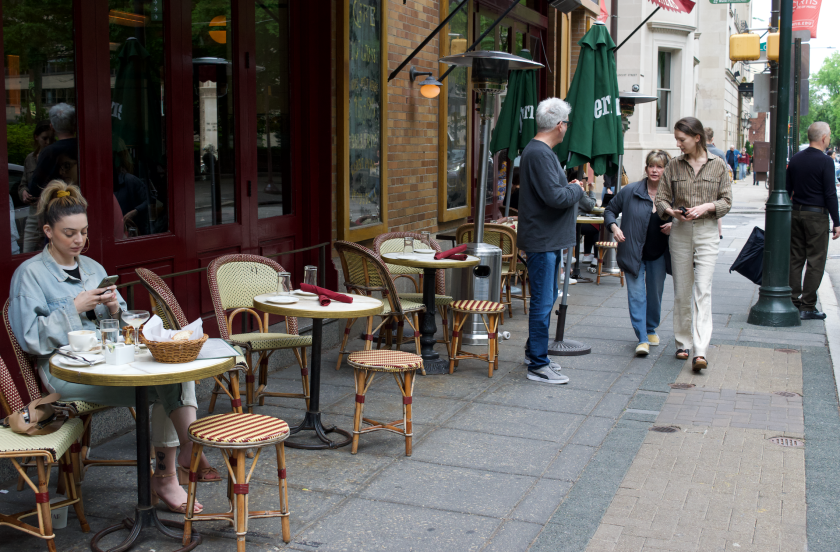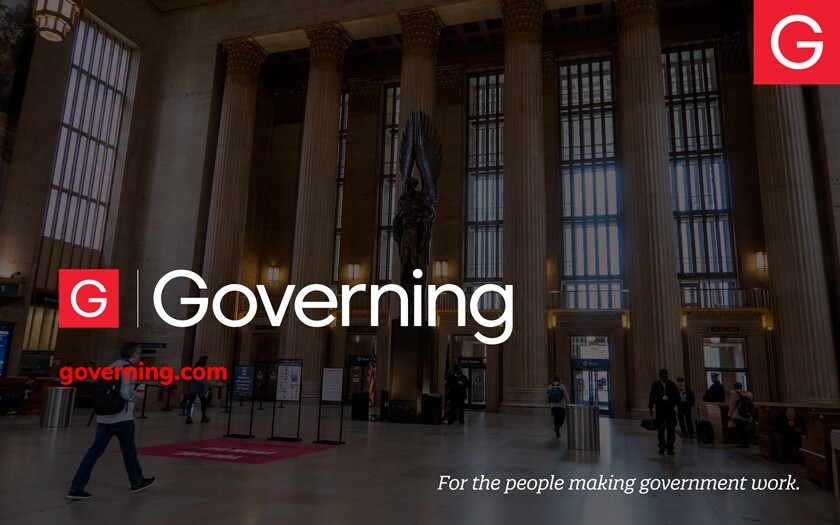In Brief:
Like a lot of big-city downtowns, Center City Philadelphia saw periods of eerie emptiness in the height of the COVID-19 pandemic. But it doesn’t feel that way anymore.
According to a new report from the Center City District, a business improvement district in downtown Philadelphia that runs street-cleaning and improvement projects and manages a series of public parks, pedestrian traffic in the area has reached 84 percent of 2019 levels. The area has also seen substantial residential growth in recent years. Retail occupancy has basically recovered to pre-pandemic levels. And 70 percent of non-resident office workers are working in the office on most days. The numbers are still inching upward — as they are, to varying degrees, in many big cities.
Still, says Prema Katari Gupta, the president and CEO of Center City District, it might be time to stop thinking about the trajectory of downtowns in comparison to what they were like before the pandemic.

Erin Ingraffia/Erin Ingraffia
Gupta recently spoke with Governing about the rebound in foot traffic in downtown Philadelphia on nights and weekends and the enduring challenges of refilling office space. The interview has been edited.
One of the opportunities has really been creating these beautiful and optimistic moments in the city that we’re able to amplify beyond who experiences them physically.
Governing: In terms of the experience or the vibe, what is Center City Philadelphia like right now compared to before the pandemic?
Prema Katari Gupta: I think we’re in a great place. If you are downtown, quite honestly, walking the streets, it feels really good. Perhaps it doesn’t feel good when you’re stuck in traffic on the highway if that’s how you get to work, but at this point, we’ve got 85 percent of the people that we had pre-pandemic. We’ve got a fairly diversified downtown ecosystem. We do really well with both residents and essential workers. The mix has changed a little bit and the patterns have changed a little bit. The narrative we tried to create with this report is, let’s stop looking backwards — let’s look forward. We’ve got work to do and let’s focus on the downtown we want to create and what our region needs, with a sense of optimism that our best days are ahead of us.
Governing: What makes Philadelphia unique in terms of its downtown trajectory and what commonalities does it have with other big-city downtowns?
Gupta: In some ways we’re ahead of other cities and in some ways we’ve got work to do. A positive is the residential population. Over the last 25 years we’ve converted at least 40 office buildings to either residential or hotels. We have been converting office to residential since before that was a cool urban trend. That’s in combination with a lot of ground-up multifamily residential and condo construction as well.
In downtown Philadelphia you see a pretty strong retail environment that supports all of these users. We survey every ground floor space in the district twice a year — a visual survey of active use. Pre-pandemic, it was about 89 percent occupancy. In the summer of 2020, when there was civil unrest and shutdowns, it was down to 65 percent. It’s now back up to 85 percent and climbing upwards.
It feels different because Ann Taylor is gone and Gap is gone and Banana Republic is gone and one of the H&Ms closed, and these are the stores that a lot of people thought that we’d be shopping at forever. But what’s happened to them has not been about Philadelphia. It’s not been about downtowns. It’s that some of these legacy retailers, particularly when everything got shut down, weren’t as focused on online retail as they should have been. A lot of those retail spaces converted very quickly to, I think the kids call them “clicks to bricks.” They’re digitally native retailers: Allbirds, Warby Parker, Bonobos, Faherty. I’ve been told by experts that we’re one of the top markets in the country for those. That’s something that I think is changing everywhere and it’s certainly legible in our downtown.
As a city we underindex on private-sector jobs. We are a massive city. But if you look at the list of the largest employers in the city, so many of them are tax-exempt. We’ve got a lot of eds and meds certainly but it would be nice to have a few more Comcasts and Aramarks and the like.
Whether it’s folks in the cities or folks in the suburbs, there’s only one downtown.
Governing: Drawing suburbanites downtown has been the paradigm for downtown booster organizations for generations. Should cities be making big investment decisions based on the hope that suburbanites will return in force?
Gupta: One of the things we’ve been curious about as we think about getting people back downtown — “back” in air quotes — is this whole missing 15 percent. We have 85 percent of the people we had pre-pandemic. How much of our energy should we be dedicating on getting that last 15 percent back?
I’m thinking about my father-in-law who is in his 80s, a former Philadelphia Orchestra subscriber for probably 40 years, and he’s now said, “you know what, I’m getting too old to do this.” The orchestra is doing some really cool stuff around happy hours and more engaging concerts. Should we be thinking about the next 15 percent of customers across all of these asset classes?
I’m not a native Philadelphian. I think that the quality of life on offer here is phenomenal. If we do think there is some disruption, particularly in higher-cost cities, around people’s connections between their offices and residences, that to me is a play for Philadelphia and everything within a 20-minute walk of 30th Street Station. If you like downtowns and you like cities, there’s no better city on the East Coast because of our affordability relative to the other great cities on the East Coast. There’s some real opportunities for us to think about who our future customers are.
I’m not sure a specific strategy around attracting people from the suburbs makes sense. But every region has one downtown. It’s where arts and culture are, it’s where the great dining is, and it’s where you can get without a car. And that is something that makes the audience for downtown regional. Whether it’s folks in the cities or folks in the suburbs, there’s only one downtown. We need to play that role. It’s not just folks in the suburbs, it’s everyone — visitors and tourists too.
Governing: I saw in the report that foot traffic on nights and weekends is above pre-pandemic levels. How do you think the city can take advantage of that?
Gupta: Our mantra in the office is “both/and.” I’ve had a couple other reporters ask, should we be giving up on offices and focusing on residential? Absolutely not. We need all of these things. They all reinforce each other in a way that I would argue has very visibly been proven in the last couple years.
But yes, we are heartened by the nights and weekends numbers. If you talk to many of our restaurateurs I think they’re pleased as well. Top of mind for them is not demand — it’s labor.
There are a lot of folks who claim that what’s keeping them away from Center City is concerns about public safety. This report also has data reinforcing the fact that crime has gone down — I’m contradicting myself in comparing this to 2019 — but crime is lower in Center City than it was in 2019. But we now get our information in goofy ways. Algorithms amplify the stuff we prefer they wouldn’t. So perceptions get altered by that.
Governing: Center City District controls a couple of high-profile parks and public spaces downtown. What role have those played in managing the look and feel of Center City?
Gupta: We, like a lot of cities, have some quality-of-life challenges. We have people in crisis and people who we need to take care of. We have homelessness outreach teams that work on those issues in a really thoughtful and humane way. But I think what the parks do — again, these are environments that we largely control through leases with the city — we’re able to really create some beautiful images of optimism. You’ve got to reach people in a lot of different ways. Some people will respond to stats that show we have 85 percent pedestrian recovery and 18 percent less crime than 2019. But some people want to see a spectacular art installation above a skating rink or children playing in fountains. In some ways, one of the opportunities has really been creating these beautiful and optimistic moments in the city that we’re able to amplify beyond who experiences them physically. The other piece of it is proof of concept that well-managed public spaces have recovered. All cities need more resources around those for their downtowns.
Governing: Are there things that you worry about, vulnerabilities that could turn into big problems?
Gupta: We do want to see more people coming back to the office. Generally speaking, offices as an asset class are a vulnerability for all of us. Nationally, trophy and Class A office spaces are doing very well. But I think we’re just generally concerned about Class B office space. A lot of the buildings that are easy to convert have already been converted. If we do have this excess inventory, I think we need to figure out what happens. We’ve had this very strong residential growth but it needs to be growth across sectors and across populations.
Governing: What else do you want to say?













